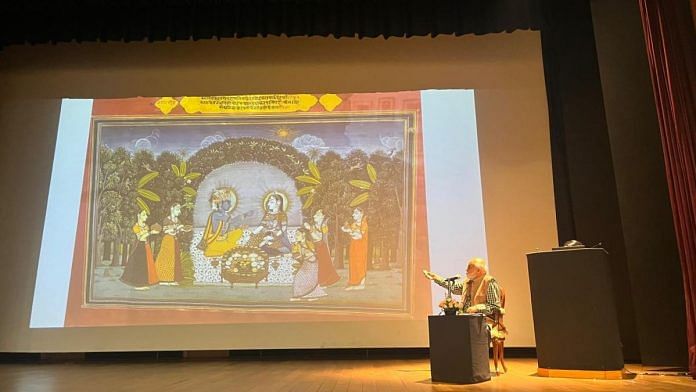New Delhi: World over, artists have captured the convergence of food and art. Da Vinci’s ‘Last Supper’, Andy Warhol’s ‘Campbell Soup’, and Paul Cezanne’s ‘Peaches and Pears’, to name a few. In India, however, this is a less-explored area of research. But on 9 April afternoon at Delhi’s National Museum, food critic and historian Pushpesh Pant took the audience through an illustrated talk on food represented in the artistic masterpieces from the National Museum collection.
Pant delivered the talk titled Encountering Indian Food in Art and Sculpture, part of the National Museum Lecture Series, in the presence of BR Mani, Director General of the National Museum, a celebrated archaeologist himself. In his welcome address, Mani mentioned the recent introduction of the scientific tests of food remains in archaeological analysis in India.
The presentation began with the mention of Ganesh, the pot-bellied god whose trunk reaches for laddoos in the north-Indian iconography, and modaks in those south of the Narmada river. Pant took the audience through the paintings in the Ajanta Caves, where food bridges the gap between the earthly and the divine; Pichwai art depicting ‘Annakut’, a mountain of food, and the cherubic Gopal Krishna in ornate Tanjore paintings, clutching either a laddoo or white butter.
It was a packed auditorium on a weekday afternoon with people from all walks of life. Apart from curators, conservators, and researchers, a huge flock of enthusiastic students formed the congregation.
Krishna and food art
Pant, one of the few scholars on the subject in India, brought the attention of the audience to the depiction of food in the stories from the Mahabharata.
Satyavati, the great-grandmother of the Pandavas and the Kauravas, seduced sage Parashar to receive the boon of a sweet smell, which would eventually enable her to seduce Shantanu, the king of Hastinapura (the great-grandfather of the Kauravas and the Pandavas).
The discussion on food in Indian art is incomplete without the mention of Krishna. And it was no different in Pant’s hour-long talk.
The art enthusiasts witnessed Krishna through his many ages. Balagopala in embellished Tanjore paintings; and as Srinathji, the eight-year-old Krishna lifting Govardhan parvat on his little finger, surrounded by an Annakut feast in Pichwai paintings.
Pant said that India was known as the country of milk and honey, especially in the province of Punjab, something that continues to this day. “Milk and all its products are auspicious and satvik in any of its forms, like khoya or chhach…and you would see, why is he [Krishna] so happy with his matka of dahi.”
Also read: Very few talk about Tagore’s politics today. Bengal remembers him for his art, poetry
Mughals and the white Mughals
Using the exquisite miniature paintings, the speaker transported the audience to the Mughal picnics. Private and secluded, the Mughal gardens afforded men and women the opportunity to partake in drinking, feasting, and mingling without many of the social constraints that normally governed their lives.
Pant also talked about the evolution of kebabs through a Mughal miniature painting depicting two noblemen dining with an array of served delicacies.
The retired JNU professor eloquently extrapolated the imagery of the Mughal picnics to the garden parties of the ‘white Mughals’—-the British.
The English who wanted to culturally replace the Mughals as new rulers, mimicked these garden picnics. The most famous ones were held at the Red Fort and around various venues during the Coronation Durbars of 1877, 1903, and 1911.
One miniature painting that stood out in the presentation was that of Ram, Sita and Lakshman where Lakshman is probably making ‘shoolays’— a barbeque of sorts, like grilling kebabs.
“Popular beliefs dictate that the process of skewing meat came with the Muslims, but Rajputs [and other warrior tribes] always had their respective ways of cooking meat outdoors,” Pant said.
Shilpi Goswami is an intern who graduated from Batch 1 of ThePrint School of Journalism.
(Edited by Ratan Priya)






